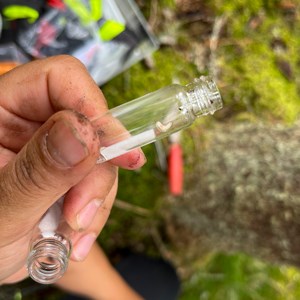Contact
 Paul Becher
Paul Becher
Researcher at the Department of Plant Protection Biology

Flies from the genera Medetera can sense and find the bark beetle Ips typographus that is a severe insect pest on Norway spruce. A synthetic blend of the compunds that the flies react to can facilitate biological control of the bark beetle. The picture shows a Medetera larva isolated from an infested spruce tree.
Long-legged flies of the genus Medetera are the most relevant natural enemies of the spruce bark beetle Ips typographus, which causes enormous damage in European spruce forests.
Medetera flies lay eggs onto infested spruce trees where the larvae go into the beetle galleries to prey on the developing beetles. For making better use of the flies in forest management it is important to understand the ecological interactions between predator and prey. An important question in this context is how the flies find the beetles that develop under the bark.
– Our studies show that Medetera flies are able to sense specific odor compounds emitted by the beetles and the infested trees. That means that the flies can sense and find them, even when the beetles are hidden inside the tree, says Maria Sousa.
– A synthetic blend of these compounds can be used to attract and to monitor the flies for conservation biological control, says Paul Becher.
 Paul Becher
Paul BecherResearcher at the Department of Plant Protection Biology
Read the article “Odors Attracting the Long-Legged Predator Medetera signaticornis Loew to Ips typographus L. Infested Norway Spruce Trees” in Journal of Chemical Ecology.